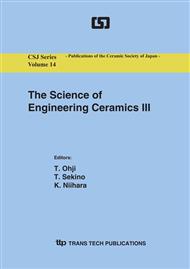p.263
p.267
p.271
p.277
p.281
p.285
p.289
p.293
p.297
Critical Frontal Process Zone Size and R-Curve Behavior of Porous Ceramics
Abstract:
Although porous ceramics are materials with high potential for helping conserve the environment, the characteristics of pore-related mechanical properties have not yet been examined sufficiently. The R-curve behavior of porous ceramics was estimated using the crack stabilizer technique developed by Nojima et al. Also, the critical frontal process zone (CFPZ) size for porous ceramics was estimated from the strength and fracture toughness of the materials used. The results revealed that the R-curve behavior was almost flat in porous ceramics, in contrast with a steeply rising R-curve behavior for porous silicon carbide observed previously, and that the CFPZ size of porous ceramics was larger than that of dense ceramics. A schematic explanation for the crack extension in porous materials was presented to discuss the R-curve behavior of porous ceramics.
Info:
Periodical:
Pages:
281-284
Citation:
Online since:
August 2006
Authors:
Price:
Сopyright:
© 2006 Trans Tech Publications Ltd. All Rights Reserved
Share:
Citation:


